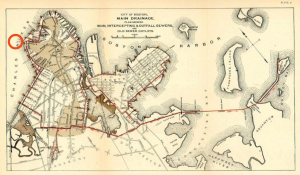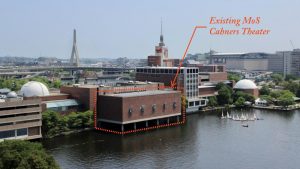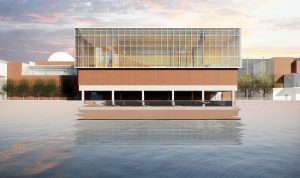Structural engineering, at its core, is the practice of shaping the path forces take to the ground. The magic of the profession is in how these paths are shaped. As designers, we typically exercise a reasonable amount of control over them. We dictate point A and point B and determine the shape in between. In the case of the Boston Museum of Science (MoS) Public Science Common (PSC), the site and its history constrained these points in unique ways. These constraints influenced and, in many ways, drove the design of this one-of-a-kind space.

Figure 1 – Main Drainage Works of the City of Boston (ca. 1888 / Boston Water and Sewer Commission) present MoS location (marked)
Boston’s History of Land Building
Boston is known for its rich history. Most people are familiar with the city as the site of Paul Revere’s midnight ride or as the cradle of the American Revolution. However, few are aware of the centuries of land building in the city that created the geography we see today. Much of the land forming the neighborhoods of Back Bay, Cambridge, Seaport, and East Boston was either wholly or partially non-existent before the year 1630. If you were to stand on Newbury Street in the year 1600, you would find yourself not on terra firma but submerged in a brackish estuary. This body of water, now non-existent, once fed into Boston Harbor. It ebbed and flowed with the tides until, in 1910, the construction of the original Charles River Dam separated the salt and freshwater bodies.
The Original Charles River Dam
This was not done for energy production or water traffic control. The dam was constructed because, in previous years, the area had become a discharge point for the city’s sewage (see Figure 1). Combined with the sun at low tide in the summer, the smell was famously unbearable. A plan was proposed in 1894 and again in 1901 to construct an esplanade and prevent tidal ebb by building a dam. This dam, the original Charles River Dam, was built on the site of the present-day MoS between 1905 and 1910. However, it did not solve the issue of smell. Blocking the end of the river prevented it from flushing with the tide and created a settlement basin for contaminants, allowing the condition of the river to persist.

Figure 2 – Original Charles River Dam location ca. 1957 (left), present day (right)
Existing Cahners Theater
The original Cahners Theater is a 1960s structure built in a manner that was responsive to these conditions. A theater space demanded control of acoustics and lighting. This, combined to separate the space from the river, led to its construction as a rectangular concrete and masonry structure stilted on six caissons above the water. Since its construction, however, the river has changed. The original Charles River Dam was replaced by the 1978 Charles River Dam downstream, improving fish migration. The completion of the Deer Island Plant, combined with increased environmental regulations and efforts by organizations such as the Charles River Watershed Association, has reduced combined sewer outflows by over 90%. The river has achieved a water quality rating of B+ as of 2024.

Figure 3 – Existing Cahners Theater
Public Science Common
Like Cahners Theater, the Public Science Common will be responsive to its environment and history. Balanced upon the existing stilted caisson foundations, the windowless masonry massing seen today will be replaced by a glass volume with a 40ft high, with a double-skinned façade. It will offer stunning panoramic views of Boston and Cambridge, providing a multi-use convening space for the community while passively moderating its temperature year-round.

Figure 4 – Museum of Science Public Science Common (rendering courtesy of William Rawn Associates)
In this blog series, we will detail the engineering behind this state-of-the-art space. From point A to point B, join us in the shaping of the Museum of Science Public Science Common.
Coming in Blog#2: The surgical removal of the existing Cahner’s Theater and structural support of the Public Science Common…

